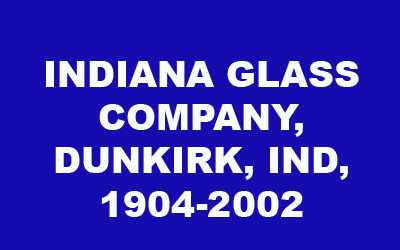|
Indiana Glass Company History

| Indiana Glass Company History |
Indiana Glass Company, Dunkirk, Ind. (1904-2002).
The origin of this factory began with the Beatty-Brady Glass Company, founded in 1895 and in operation in Dunkirk by 1897. In 1899, when the National Glass Company was formed, Beatty-Brady was one of the companies acquired by the combine. Frank W. Merry became superintendent and, in 1904, was involved in the formation of the Indiana Glass Company, which leased the plant from the National. After the failure of the National Glass Company, Merry and a group of associates purchased the factory and Merry remained president until his death in 1930.
Early production ranged from jelly tumblers to imitation-cut tableware, both in original designs and from molds obtained from the Model Flint Glass Company of Albany, Ind., and the Indiana Tumbler and Goblet Company of Greentown, Ind. (both of which had also joined the National Glass Company). In the 1920s, they introduced a variety of old Sandwich reproductions as well as a series of very modernistic designs, strongly influenced by the Art Deco movement, including the very popular Tea Room pattern, while also producing large quantities of colonial style soda fountain and restaurant ware. Many of these patterns were to remain staples for years or were periodically reissued to attract new generations of glass buyers. Production during these years was both hand-made and machine-made. Simultaneously, the company also specialized in the production of automobile headlight lenses and other industrial glassware, at one time producing about 80% of the lenses used in the United States.
By the 1950s, the company had encountered financial difficulties, including the acquisition of the Sneath Glass Company of Hartford City, Ind., in an unsuccessful attempt to transition to the manufacture of sealed-beam headlights, which had overtaken the old-style auto lenses in popularity. For a time, stockholders were forced to step in and take over management of the plant, but ultimately the company came back stronger than ever beginning with a merger with the Lancaster Lens Company of Lancaster, Ohio, to become the Lancaster Glass Corporation and, ultimately, the Lancaster Colony Corporation in 1962. As the Indiana Glass Division of the new conglomerate, the Dunkirk factory continued to make glass under its own name, as well as under the Colony Glassware label for Pitman-Dreitzer & Company, Inc
Throughout the later years, Indiana not only continued to introduce new patterns, but also frequently reissued patterns originally brought out in the 1920s and 1930s. They also acquired and reworked molds from many other companies, including McKee, Paden City, Jenkins, U.S. Glass, Duncan and Miller, and Imperial.
This trend reached a climax in 1970 when Tiara Exclusives was formed as an offshoot of Indiana Glass. Tiara made no glass themselves but offered sales through a home party plan where hostesses received premiums and bonuses for selling products to friends and invited guests. Jim Hoofstetter, one of the founders of Tiara Exclusives, was a former president of Indiana Glass. Between 1970 and 1998, a majority of Tiara's glassware was made from Indiana molds (or other molds acquired by Lancaster Colony, Indiana's parent company) and most of it was produced at the Dunkirk factory. The Sandwich pattern was Tiara's most successful line, continuing to be sold throughout the entire span of Tiara's existence. It consisted primarily of pieces originally made by Indiana from the 1920s on, supplemented by additional items from Duncan & Miller's Early American Sandwich pattern.
By the time that Indiana discontinued handmade operations sometime in the mid-1980s, some Tiara pieces were also being produced by other companies, most notably the Fostoria Glass Company (which had also become a Lancaster Colony division around 1987), the Fenton Art Glass Company and the L. E. Smith Glass Company. Both Fostoria and Fenton produced candlesticks for Tiara from Indiana molds as well as from their own molds and other companies may have done so as well.
In late 2002 all glassware manufacture was discontinued at the Dunkirk factory and consolidated in Lancaster Colony's Sapulpa, Oklahoma, plant (formerly Bartlett-Collins).
? Adapted from The Glass Candlestick Book, volume 2, by Tom Felt, Rich & Elaine Stoer (reprinted with permission) |
| Keywords: |
|
| Date: |
22.04.2007 01:57 |
| Hits: |
21227 |
| Added by: |
Tom Felt |
|
|
Powered by 4images 1.9
Copyright © 2002-2024 4homepages.de
Copyright © 2003 - 2019 Glass Etch and Pattern Gallery. All rights reserved, foreign and domestic.
|

